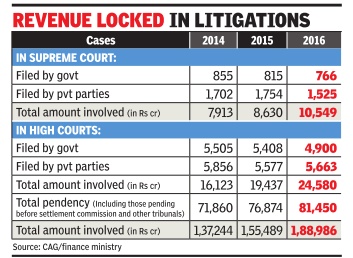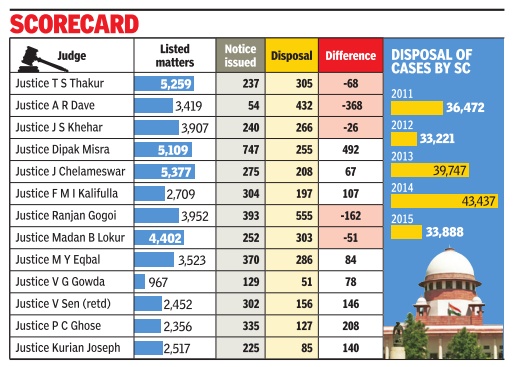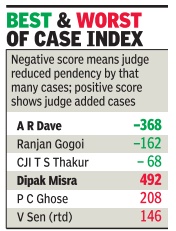Supreme Court, India: Administrative issues
This is a collection of articles archived for the excellence of their content. |
Contents |
Administrative expenditures
Air travel of judges, 2013-16
The Times of India, Jun 17 2016
Dhananjay Mahapatra
At Rs 1 Lakh, Gogoi & Chelameswar Stand Last: RTI
Supreme Court judges may be neck deep in work but that has not confined them to the courtroom and case files with many judges clocking impressive flying hours in the last three years. In response to an RTI query from advocate Gaurav Agrawal, the SC Registry has provided interesting information about the countries visited by several judges along with their spouses from April 2013 to March 2016 and the airfare borne by the apex court.
Justice A K Sikri till March 2016 undertook seven trips abroad with his wife. They visited AmsterdamHague (Netherlands) with transit through London and Dubai (UAE), Singapore (twice), Hong Kong, Brussels with transit through Zu rich, Macao (China) with transit through Hong Kong and Beijing, and Tel Aviv with transit through Zurich. In total, their air tickets cost the SC Rs 37.91 lakh.
CJI T S Thakur and his wife visited Colombo (Sri Lanka), Canberra (Australia) with transit through Singapore and Sydney , St Petersburg (Russia) with transit through Moscow and Dubai, Ithaca, Washington and New York (all in the US) with transit through London (UK) and Newark and Chicago (US). The air tickets cost the SC Rs 36.88 lakh.
Justices J Chelameswar and Ranjan Gogoi figured last in the list, having incurred the least expense on air tickets despite travelling with their spouses. Justice Chelameswar took one trip abroad to Kathmandu which cost the SC Rs 1.13 lakh while Justice Gogoi's trip to Bhutan cost the top court Rs 1.46 lakh.
Justice Madan B Lokur took the land route and travelled alone to Islamabad and Bhutan and claimed nothing but took two trips abroad with his wife to Bermuda with transit through London, and Antalya with transit through Istanbul (both in Turkey). The SC paid Rs 25.09 lakh for the air tickets.
Justice Anil R Dave and his wife travelled to Canberra (Australia) with transit through Singapore and Sydney , and Strasbourg (France) with transit through Paris and Zurich (Switzerland). The cost of air travel was Rs 17.93 lakh.
Justice J S Khehar and his wife undertook just one foreign trip to Sanya and Boao-Hainan provinces in China with transit through Beijing and Hong Kong which entailed a cost of Rs 6.85 lakh.
Justices F M I Kalifulla and S A Bobde both travelled abroad alone.Justice Kalifulla went to Strasbourg (France) with transit through Paris and Zurich (Switzerland) costing Rs 9.18 lakh. Justice Bobde went to New York for which the air tickets cost Rs 4.50 lakh.
Career paths of CJIs, SC judges
Three CJIs in a row from Karnataka High Court
Oneindia | 4th Dec, 2015
Source: www.oneindia.com
Justices Dattu, Thakur and Kehar: Karnataka High Court's rare distinction
For Karnataka, Justice T S Thakur being sworn in as the Chief Justice of India is quite a rare distinction. He took over from Justice H L Dattu and after his retirement, going by the seniority list, it would be Justice Kehar who is likely to be the Chief Justice of India.
Now what is common is that all three have served in the Karnataka High Court. Justice Kehar had in fact served as the Chief Justice of the Karnataka High Court before his elevation to the Supreme Court. Three Chief Justices and the Karnataka connection: Justice H L Dattu who just retired as the Chief Justice of India was appointed as Judge of the Karnataka High Court on December 12 1995. He was then transferred to the Chattisgarh high Court and elevated as its Chief Justice.
He was then transferred to the Kerala High Court before being appointed as a Supreme Court judge in 2008. Justice T S Thakur was appointed as an Additional Judge of the High Court of J & K on 16th February, 1994 and transferred as Judge of the High Court of Karnataka in March, 1994.
He was appointed as a permanent Judge in September, 1995. Was transferred as a Judge of the High Court of Delhi in July 2004. He was then appointed as Acting Chief Justice of Delhi High Court on 09.04.2008 and took over as Chief Justice of the High Court of Punjab and Haryana on August 11, 2008. He was elevated as Judge of Supreme Court and assumed charge on 17.11.2009 and appointed as Chief Justice of India on 03.12.2015. He is due to retire on January 4th 2017.
After Justice Thakur retires, going by the list, Justice J S Kehar will be appointed as the Chief Justice of India. Although Justice Anil R Dave is senior, he will retire on November 18 2016. Post his retirement, Justice Kehar who has a tenure up to August 28 2017 will be the senior most judge. Following Justice Thakur's retirement on January 4 2017, Justice Kehar will take over as Chief Justice of India and would have a tenure of 8 months. Justice Kehar was elevated to the Bench of High Court of Punjab and Haryana, at Chandigarh, on February 8, 1999. He was appointed as Acting Chief Justice of the Punjab and Haryana High Court twice i.e., with effect from August 02, 2008, and again, with effect from November 17, 2009.
He was elevated as Chief Justice of the High Court of Uttarakhand, at Nainital, on November 29, 2009 and thereafter he was transferred as Chief Justice of High Court of Karnataka, where he assumed his office on August 8, 2010. He was appointed judge of the Supreme Court on September 13, 2011.
Disposal of cases
2015, July-Dec: disposal of cases by individual judges
The Times of India Jan 08 2016
Dhananjay Mahapatra
33,888 Cases Cleared In 2015
Chief Justice of India T S Thakur recently conducted a first-ever internal study to assess the individual contribution of 13 senior judges, heading two or three-judge benches in the Supreme Court, in reducing pendency of cases. The conclusion: five of the judges chipped away at pendency while the others added to it.
Tackling pendency was always seen as a collective task in the Supreme Court and individual efforts of judges were seldom focused upon. But CJI Thakur, after taking over on December 2, asked the SC reg istry to determine how each of the 13 judges had performed in terms of disposal of cases in the past six months -from July to December 2015. However, the index may not be an indicator of how the judges performed. One judge may have got cases involving complex questions of law or Constitutional issues, requiring hearings running into days and impeding the bench from disposing of a large number of cases, while others may have handled simpler cases allowing them to score higher.
The study had just three parameters: number of cases listed before the judge, number of cases in which notice was issued (meaning that many cases were introduced into the justice delivery system) and number of cases disposed. The difference between the number of cases a judge introduced into the system by issuing notice and the number of cases disposed of showed his disposal rate. If the number is positive, the judge added to case pendency; if negative, the judge helped to bring down pendency .
The list compiled by the registry took into account the disposal by the judges till 11.25am on December 12, 2015.From the list compiled, Jus ices A R Dave, Ranjan Gogoi, CJI Thakur, Madan B Lokur and J S Khehar reduced pendency while the remaining eight contributed to it. Justice Dipak Misra added the high est number of cases, followed by Justices P C Ghose, V Sen, Kurian Joseph, F M I Kalifulla, M Y Eqbal, V G Gowda and J Chelameswar. Justice Sen retired on December 30.
Disposal of cases since 2011 by the Supreme Court also saw wide fluctuations. It was 36,472 cases in 2011; 33,221 in 2012; 39,747 in 2013; 43,437 in 2014 and 33,888 in 2015.
Nature of cases considered
Government main litigant, taxation cases dominate

The Central Board of Excise and Customs (CBEC), the agency responsible for collecting indirect taxes, has been the biggest litigant in the last three years, filing twice as many appeals in the Supreme Court than private companies, a study by the government's official auditor showed.
A case study for financial years (FYs) 2014, 2015 and 2016 on the total pendency of cases related to indirect tax disputes shows that on an average, the government has been filing over 1,700 appeals annually in the apex court, despite the fact that its success rate (winning cases) came down from 19% in 2014 to 11% in 2016.
In addition, the government has been filing at least 5,000 cases every year before various high courts. The success rate in high courts was worse -coming down from 34% in 2014 to 18% in 2016. If we combine cases pending before several appellate tribunals and commissioners of appeal of the CBEC, the revenue locked in litigation was estimated at Rs 1.89 lakh crore at the end of March 2016.
The Comptroller and Auditor General, which raised the issue in its latest report tabled in Parliament on Friday , has suggested that steps should be initiated to bring down litigation, particularly in view of the department losing a large number of cases in the highest court.
“Huge amounts of revenue remain outside the Consolidated Fund of India for substantial periods of time,“ the CAG said, based on data analysed from CBEC records. The auditor tabulated the pendency of cases in various forums, segregating them by those filed by private entities and the number of cases in which the government has gone in appeal before higher courts.
The revenue locked in li tigation was to the tune of Rs 1.37 lakh crore in 2014, which went up to Rs 1.55 lakh crore in 2015 and to Rs 1.89 lakh crore in 2016. Disputes related to indirect taxes take decades to get resolved, starting from department related appellate authorities, the settlement commission, high courts and the Supreme Court.
In many cases, the dispute arose due to “the department resorting to coercive recovery measures“ while in some instances a dispute was allegedly allowed to remain unresolved for years which benefited private companies that find enough fiscal space by holding back on payment of assessed taxes.
Out of turn listing of petitions
2017: tussle between queue-breaking senior advocates, juniors
An unsavoury tussle between queue-breaking senior advocates and queue-stuck junior advocates broke out in the open in the courtroom of the Chief Justice of India on Tuesday during the chaotic first 20 minutes of the daily ritual of `mentioning' for out of turn listing of a petition.
Petitions filed in the SC get into a queue for listing before a bench when their turn comes. But the CJI, being the administrative head, has the power to order out of turn listing of a petition if a lawyer convinces him in open court about the `grave urgency' requiring early hearing.
A good 20 minutes before the CJI and his companion judges assemble in courtroom No.1of the SC, the queue of advocates for mentioning for out of turn listing gradually builds up. This practice has been in vogue for years.When Justice J S Khehar was CJI, the queue was at its shortest as he used to reject 90% of the requests for early listing. But the queue got longer with the benevolent and accommodative nature of CJI Dipak Misra.
The advantage with senior advocates is that they do not have to stand in queue like the juniors to await their turn. Many a time, given the large number of cases that Justice Misra lists before his bench daily , the CJI would take requests for early listing for 20 minutes and abruptly end it saying “no more mentioning“. .
On Tuesday, as soon as the CJI said no more mentioning, advocate P V Dinesh complained to the CJI with folded hands that he had been standing in the queue for 30 minutes and his chance did not come to mention a petition for early listing. “The senior advocates have made multiple mentioning as they don't have to stand in queue. They break the queue and we are left standing,“ he said. Former attorney general Mukul Rohatgi mentioned a petition at the beginning of the ritual and then came back to mention another.
Dinesh said, “It was the tradition of the court that senior advocates should not mention petitions for early listing.“ This rubbed the CJI the wrong way . He asked, “No one else knows the tradition? Only you know it? Everyone should learn from you?“ This exchange between the advocate and the CJI gave a fresh impetus to the junior advocates to make fresh attempts to start the mentioning ritual afresh. But the CJI stopped it by asking them to leave the early hearing request forms with the courtmaster and promised to look into them to list the cases between October 3-10.
Vacation bench
2014-16: Hardly used
The Times of India, Jun 02 2016
Only a handful of cases have been listed every day before the vacation bench of the Supreme Court in between May 16 till end of May, belying the strong criticism of the apex court and its judges for a seven-week summer holiday. On Wednesday , only five fresh cases were listed for hearing. In the last 13 days, the number of fresh cases listed before the bench did not touch double digits on six days. Only three fresh cases were heard on May 19. Together, in the last 13 days of the vacation, 209 fresh cases were listed. Apart from the 209 fresh cases, the vacation bench heard 183 old matters.
On a regular working day , an SC bench hears more than 60 cases on average. By contrast, the vacation bench took up 30 cases, both fresh and old, daily .
Most advocates who have a good practice are vacationing abroad. In their absence, the client does not want a junior advocate to argue their case. As a result, not many cases get listed. In the late 1990s, there used to be a single vacation bench that held court only twice a week. Gradually , its frequency was increased to three days a week and then it held court daily . With more cases pouring in during the vacation, the number of benches was increased to two and then three.
But in 2014-16, only one vacation bench sits daily to deal with the small number of cases that get listed for hearing.
This time around, Chief Justice of India T S Thakur's persuasion saw many advocates agreeing to list their cases for hearing during the summer holidays. As the vacation drew closer, there was a long queue of advocates before the CJI's bench every day and many of them sought to withdraw their earlier request for listing cases during the summer break. The CJI tried to persuade the advocates to change their mind, but not many actually did. Because of this, only a handful of cases got listed during the summer break.
It was during the tenure of Justice Y K Sabharwal as CJI that the nine-week summer vacation was curtailed to seven weeks. Thereafter, Justice P Sathasivam attempted to reduce it to four weeks, but he reportedly faced strong opposition both from judges and advocates. As the British legacy of summer break continues, there is little chance of it getting reduced without the cooperation of advocates.
See also
Supreme Court: India (mainly SC's rulings)
Supreme Court, India: Administrative issues

